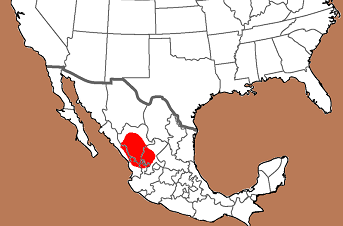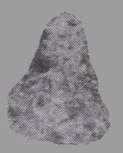Outline is Representative of Size and Shape:


Name Details:
Identified By: Michael W. Spence
Named For:
Date Identified: 1971
Type Site:
Identified By: Michael W. Spence
Named For:
Date Identified: 1971
Type Site:
Point Validity:
Valid type
Michael Spence is a distinguished anthropologist who retired Professor Emeritus from the Department of Anthropology, University of Western Ontario. He conducted extensive research in Mexico and Ontario. This type was identified in his publication on cultures of Mexico.
Michael Spence is a distinguished anthropologist who retired Professor Emeritus from the Department of Anthropology, University of Western Ontario. He conducted extensive research in Mexico and Ontario. This type was identified in his publication on cultures of Mexico.
Atotonilco Triangular
Rio Grande Triangular VariantCluster: Late Southern Triangle Cluster
Description of Physical Characteristics and Flaking Pattern:
This is a medium triangular point with an elliptical cross section. The blade ranges from primarily straight to slightly excurvate and commonly has an angular change towards the base of the point on one or both edges. The base varies from straight to slightly convex with with angularly defined basal corners. This point has a random flaking pattern.
Variation of the Rio Grande Triangular differing in the swell out , near the base, of one or both edges.
Variation of the Rio Grande Triangular differing in the swell out , near the base, of one or both edges.
Size Measurements:
Length - 30 to 40 mm (average 35 mm), Blade Width - 17 to 26 mm (average 21 mm), Thickness - 3 to 8 mm (average 5 mm)
Length - 30 to 40 mm (average 35 mm), Blade Width - 17 to 26 mm (average 21 mm), Thickness - 3 to 8 mm (average 5 mm)
Commonly Utilized Material:
Additional Comments:
The Atotonilco Triangular is a variation of the Rio Grande Triangular. The Atotonilco Triangular has an angular change on one or both edges where the Rio Grande Triangular has a smooth constant angle from the tip to the base (Spence, 1971). The Atotonilco may represent re-sharpened examples of Rio Grande points.
Distribution:

Distribution Comments:
This point is primarily associated with the Llano Grande and Suchil Chalchihuites cultures of Durango and into Sinloa, Nayarit, Jalisco, and Zacatecas.
This point is primarily associated with the Llano Grande and Suchil Chalchihuites cultures of Durango and into Sinloa, Nayarit, Jalisco, and Zacatecas.
Age / Periods:
Date: 1,800 - 1,400 B.P.
Cultural Period: Transitional Archaic to
Preclassic
Glacial Period: Roman Warm to Vandal Minimum
Culture: Llano Grande and Suchil Chalchihuites cultures
Date: 1,800 - 1,400 B.P.
Cultural Period: Transitional Archaic to
Preclassic
Glacial Period: Roman Warm to Vandal Minimum
Culture: Llano Grande and Suchil Chalchihuites cultures
Age Details:
Similar Points:
Other points in this cluster / Related / Associated Points:

